Historical Phones ☎️📱
This week at the CorrelAid #TidyTuesday coding hangout, it was Gif Galore!!
But let’s first look at the great static contributions of this week!
Static No. 1
By Thomas Handke
library(tidyverse)
library(ggplot2)
library(data.table)
library(lsr)
tuesdata <- tidytuesdayR::tt_load('2020-11-10')
##
## Downloading file 1 of 2: `mobile.csv`
## Downloading file 2 of 2: `landline.csv`
mobile <- tuesdata$mobile
landline <- tuesdata$land
mobile <- mobile[complete.cases(mobile), ]
landline <- landline[complete.cases(landline), ]
landline$mode <- "landline"
mobile$mode = "mobile"
colnames(mobile)[colnames(mobile)=="mobile_subs"] <- "subs"
colnames(landline)[colnames(landline)=="landline_subs"] <- "subs"
combined <- rbind(landline, mobile)
setDT(combined)
combined[,gdp_cat:= lsr::quantileCut(log(gdp_per_cap),5)]
ggplot(combined, aes(x=year, y=subs, color=as.factor(gdp_cat))) +
geom_smooth(method = "gam", formula = y ~ s(x, bs = "cs"), se = FALSE) +
scale_color_brewer(palette="YlOrBr", name = "log GDP per capita \n", labels = c("20th quintile", "40th quintile", "60th quintile", "80th quintile", "100th quintile")) +
labs(title = "Subscriptions by mode, year and GDP (conditional means)\n", x = "Year", y = "Subscriptions in the population (per 100 people)") +
theme_dark() +
theme(panel.background = element_rect("grey74"),
panel.grid.major = element_line(size = 0.25, linetype = 'solid', colour = "grey64"),
panel.grid.minor = element_line(size = 0.25, linetype = 'solid', colour = "grey74"),
plot.title = element_text(hjust = 0.5),
legend.key = element_rect(fill = "grey74")) +
facet_wrap(~mode, scales = "free_y") +
scale_x_continuous(breaks = seq(1990, 2020, by = 5), limits = c(1990, 2020)) +
scale_y_continuous(breaks = seq(0, 125, by = 25), limits = c(0, 130))
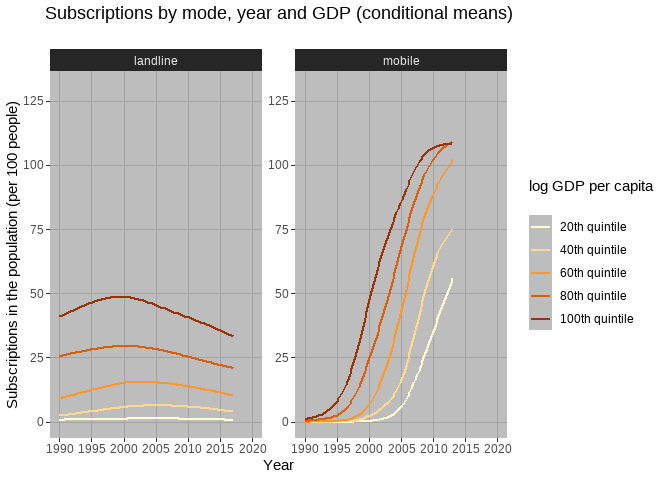
Static No. 2
By Sylvi Rzepka
library(tidytuesdayR)
library(ggplot2)
library(ggtext)
library(ggridges)
library(ggplot2)
library(viridis)
library(tidyverse)
tuesdata <- tidytuesdayR::tt_load('2020-11-10')
##
## Downloading file 1 of 2: `mobile.csv`
## Downloading file 2 of 2: `landline.csv`
mobile <- tuesdata$mobile
#Prep
mobile_afreuro<-mobile %>%
filter(continent %in% c("Africa","Europe") & year %in% c(1990,1995,2000,2005, 2010, 2016)) %>%
#orginal data: per 100 -- dividing by 100 to make a per person figure out of it.
mutate(mobile_pp=mobile_subs/100) %>%
select(code, continent, year, mobile_pp)%>%
pivot_longer(cols=continent)
#Summary
mobile_afreuro%>%
group_by(value, year ) %>%
summarise(
q10=quantile(mobile_pp,probs=(.1), na.rm=TRUE),
q25=quantile(mobile_pp,probs=(.25), na.rm=TRUE),
median=median(mobile_pp, na.rm=TRUE),
q70=quantile(mobile_pp,probs=(.7), na.rm=TRUE),
q75=quantile(mobile_pp,probs=(.75), na.rm=TRUE))
## `summarise()` regrouping output by 'value' (override with `.groups` argument)
## # A tibble: 12 x 7
## # Groups: value [2]
## value year q10 q25 median q70 q75
## <chr> <dbl> <dbl> <dbl> <dbl> <dbl> <dbl>
## 1 Africa 1990 0 0 0 0 0
## 2 Africa 1995 0 0 0 0.000120 0.000162
## 3 Africa 2000 0.000250 0.00132 0.00486 0.0107 0.0195
## 4 Africa 2005 0.0238 0.0478 0.0778 0.153 0.174
## 5 Africa 2010 0.192 0.319 0.470 0.743 0.769
## 6 Africa 2016 0.367 0.512 0.801 1.04 1.10
## 7 Europe 1990 0 0 0 0.00378 0.00481
## 8 Europe 1995 0.000287 0.00289 0.0245 0.0474 0.0617
## 9 Europe 2000 0.0265 0.172 0.422 0.619 0.642
## 10 Europe 2005 0.525 0.760 0.881 0.970 1.01
## 11 Europe 2010 0.909 1.04 1.15 1.22 1.23
## 12 Europe 2016 1.00 1.11 1.21 1.30 1.33
#Plotting
plot5<-ggplot(mobile_afreuro, aes(x =mobile_pp , y = as.factor(year), fill = as.factor(year))) +
geom_density_ridges(alpha=0.6) +
scale_fill_viridis(discrete=TRUE) +
scale_color_viridis(discrete=TRUE) +
theme_ridges() +
facet_wrap(~value) + # and country?
# edit the theme
theme(text = element_text(family = "Andale Mono"), legend.position = "none", # change all text font and move the legend to the bottom
panel.grid = element_line(color="white"), # change the grid color and remove minor y axis lines
plot.caption = element_text(hjust = 0.5, size = 8, color = "#29AF7FFF"), # remove x-axis text and edit the caption (centered and brown)
strip.background = element_rect(colour="white", fill="#FFFFFF"), # removing the gray facet_wrap box
plot.title = element_text(size = 24), plot.subtitle = element_markdown(size=9, family = "Helvetica", color = "#29AF7FFF")) +# make the title bigger and edit the subtitle (font)
# title
labs(title = "Call me mobile",
subtitle = "In 2016, 30% of Africans and 90% of Europeans have at least one mobile phone subscription. ",
x = "Number of subscriptions per person", y=NULL,
caption = "data from OurWorldInData.org")
plot5
## Picking joint bandwidth of 0.0552
## Picking joint bandwidth of 0.0558
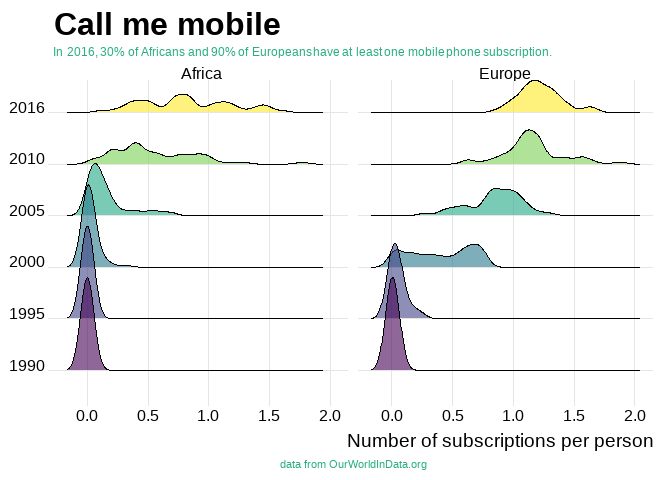
#ggsave("callMeMobile3.png")
Static No. 3
By Cédric Scherer
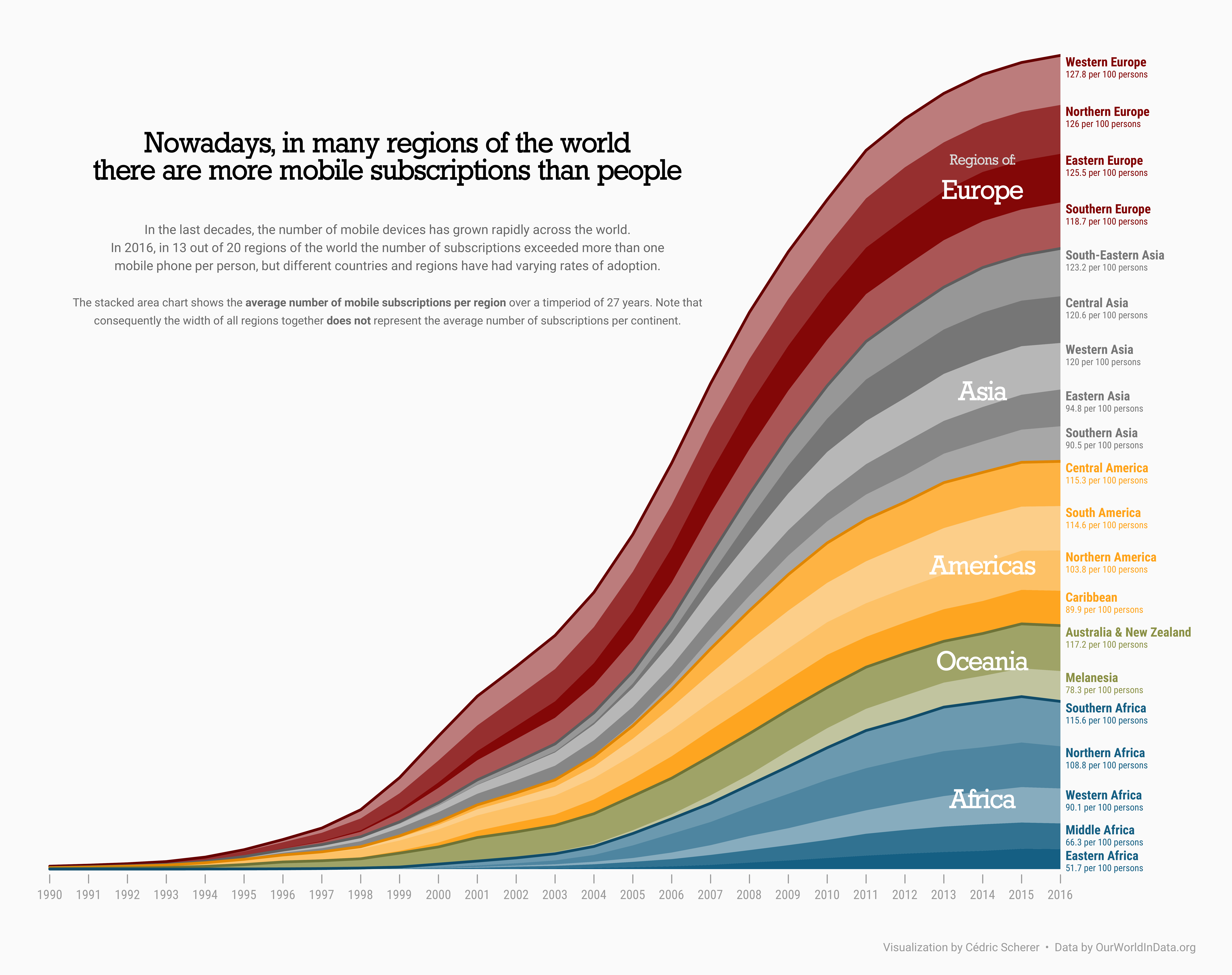
Code on GitHub
#TidyTuesday Week 2020/46 📱 Mobile Phone SubscriptionsAn area chart showing mobile subscriptions per 100 people by continent and region over time. Data by @OurWorldInData. #rstats #ggplot2 #tidyverse #r4ds #dataviz #daatviz pic.twitter.com/GRgOrwiZHK
— Cédric Scherer (@CedScherer) November 12, 2020
Now, let’s hop on the Gif train! 🚂 🚂 🚂
Gif No. 1
library(tidyverse)
library(colorspace)
library(patchwork)
library(magick)
library(ggtext)
theme_set(
theme_minimal() +
theme(axis.text = element_text(family = "Space Mono"),
panel.grid = element_blank(),
plot.title = element_text(family = "Space Mono",
face = "bold",
size = rel(1.6)),
plot.caption = element_markdown(family = "Space Mono",
face = "bold.italic",
hjust = 0))
)
world_map <- rnaturalearth::ne_countries(returnclass = "sf") %>%
select(iso_a3, geometry)
map_hist_layout <- c(
area(1, 1, 13, 14), # Map
area(12, 8, 13, 11), # Histogram
area(14, 1, 15, 14) # Slider
)
# # Determine histogram axis limit and number of bins
# mobile %>%
# semi_join(world_map, by = c("code" = "iso_a3")) %>%
# group_by(year) %>%
# slice_max(mobile_subs) %>%
# View()
mobile_img <- image_graph(875, 600, res = 96)
mobile_year_list <- group_split(mobile, year)
out <- map(mobile_year_list, function(data) {
mobile_data <- world_map %>%
filter(iso_a3 != "ATA") %>% # Antarctica
left_join(data %>%
select(code, mobile_subs), by = c("iso_a3" = "code"))
mobile_map <- ggplot(
mobile_data,
aes(fill = cut_width(mobile_subs, width = 20, boundary = 0))
) +
geom_sf(colour = "#f8f8f8", size = .25, show.legend = FALSE) +
coord_sf(label_axes = "----", expand = FALSE,
crs = "+proj=robin") + # Robinson projection
scale_fill_discrete_sequential("YlGnBu", na.value = "#cccccc", nmax = 11) +
theme(plot.margin = margin(0, 0, 0, 0))
mobile_hist <- ggplot(
mobile_data,
aes(mobile_subs, fill = cut_width(mobile_subs, width = 20, boundary = 0))
) +
geom_histogram(binwidth = 20, boundary = 0, show.legend = FALSE) +
scale_x_continuous(limits = c(0, 220), n.breaks = 12,
labels = function(x) {
x[seq(2, 12, by = 2)] <- ""
x
}) +
scale_fill_discrete_sequential("YlGnBu", nmax = 11) +
coord_cartesian(expand = FALSE) +
theme(axis.title.x = element_blank(),
axis.title.y = element_blank(),
axis.text.y = element_blank(),
plot.margin = margin(0, 0, 0, 0))
year_slider <- ggplot(data = NULL, aes(x = 1990:2017, y = 1)) +
geom_line(size = 2, colour = "#cccccc") +
geom_point(aes(x = data$year), shape = 21, size = 4.5, stroke = .6,
fill = "#f8f8f8", colour = "#26185f") +
geom_text(aes(x = data$year, y = 1, label = data$year),
vjust = 1.75, family = "Space Mono") +
theme_void()
print(
mobile_map + mobile_hist + year_slider +
plot_layout(design = map_hist_layout) +
plot_annotation(
title = "Mobile phone subscriptions per 100 people",
caption = "Source: OurWorldInData.org<br>
*Antarctica not included"
)
)
})
dev.off()
mobile_anim <- image_animate(mobile_img, fps = 2)
print(mobile_anim)
Creating visualizations during @CorrelAid #TidyTuesday meetups takes half the time it would otherwise 🚀 Here's my attempt to spice up an animated choropleth map using this week's data #rstats #dataviz pic.twitter.com/7o82bYxqyt
— Long Nguyen (@long39ng) November 10, 2020
Gif No. 2
#TidyTuesday 2020 week 46
#Load packages
library(rnaturalearth)
library(ggplot2)
library(dplyr)
library(sf)
library(gganimate)
library(rnaturalearthdata)
library(extrafont)
#Phone data
tuesdata <- tidytuesdayR::tt_load(2020, week = 46)
##
## Downloading file 1 of 2: `mobile.csv`
## Downloading file 2 of 2: `landline.csv`
mobile <- tuesdata$mobile
landline <- tuesdata$landline
#Link landline and mobile data by country/year
phone_types <- mobile %>%
left_join(select(landline, -total_pop, -gdp_per_cap, -continent), by = c("entity", "code", "year")) %>%
#Remove 2016+ because the data becomes patchy after this
filter(year <= 2015) %>%
#Convert NAs into 0s
mutate(across(ends_with('subs'), .fns = ~tidyr::replace_na(., 0L))) %>%
#Determine total number of subscriptions in each year and then determine what % of these are mobile
mutate(total_subs = mobile_subs + landline_subs,
perc_mobile = mobile_subs/total_subs) %>%
#Remove any countries that have any missing subs data in some years
group_by(code) %>%
filter(all(!is.na(perc_mobile))) %>%
ungroup() %>%
#When we create our points we don't want any that are truly size 0 (will fail to plot), so we will add a small value
mutate(perc_mobile = dplyr::case_when(perc_mobile == 0 ~ 0.001,
TRUE ~ perc_mobile))
#Load polygons of the world
world <- rnaturalearth::ne_countries(scale = "medium", returnclass = "sf") %>%
#groupby and merge any multiple polygons per country (e.g. Tasmania)
group_by(iso_a3) %>%
summarise()
#For each year, scale based on the percentage of mobile subs
plot_list <- purrr::map_df(.x = seq(min(phone_types$year), max(phone_types$year)),
.f = function(focal_year){
#Extract focal countries with data in that year
countries <- phone_types %>%
filter(year == focal_year)
#Filter world polygons
world_polygons <- world %>%
left_join(select(countries, code, perc_mobile), by = c("iso_a3" = "code")) %>%
filter(!is.na(perc_mobile))
#Extract geometries (need to be separate from data for scaling)
world_filter <- world_polygons %>%
st_geometry()
#Extract centroids of all polygons
centroids <- st_centroid(world_filter)
#Scale geometries relative to the percentage of mobile subscriptions
#When mobile subs are 100% countries will be at actual size
world_scaled <- (world_filter - centroids) * world_polygons$perc_mobile + centroids
#Replace existing geometry with scale geometry
world_polygons <- world_polygons %>%
mutate(geometry = world_scaled,
year = focal_year)
world_polygons
}) %>%
#Fix any broken polygons that prevent plotting
sf::st_make_valid()
#Create a gganimate plot
animated_plot <- ggplot()+
#Plot scaled polygons
geom_sf(data = plot_list, aes(fill = perc_mobile)) +
#Colour based on mobile subs
scale_fill_gradientn(colours = paletteer::paletteer_c("grDevices::Blues", n = 100, direction = -1) %>% as.character(),
limits = c(0, 1), name = "") +
theme_void() +
theme(legend.text = element_text(family = "Roboto")) +
#Ensure fixed lat/long range
scale_x_continuous(limits = c(-180, 180)) +
scale_y_continuous(limits = c(-90, 90)) +
labs(x = "", y = "", title = "Proportion of mobile phone subscriptions",
subtitle = "{current_frame}", caption = "Data: OurWorldInData.org | Map: @ldbailey255") +
theme(legend.text = element_text(family = "Ubuntu", size = 14),
plot.title = element_text(family = "Alfa Slab One", size = 25),
plot.subtitle = element_text(family = "Ubuntu", size = 16),
plot.caption = element_text(family = "Ubuntu Mono", size = 10)) +
#Use transition manual rather than transition_time
#transition_time has problems rendering sf polygons over time (they jump around)
transition_manual(year) +
ease_aes("linear")
Didn't get to join the @CorrelAid #TidyTuesday call, but still managed jump on the gganimate bandwagon. Wanted to make one of these scaled geographic maps for awhile so played around with polygon transforms in sf. pic.twitter.com/Z5Nl8T8Xpi
— Liam Bailey (@ldbailey255) November 11, 2020
Gif No. 3
pacman::p_load(tidytuesdayR, gganimate, here, tidyverse)
# import data
tt <- tt_load("2020-11-10")
##
## Downloading file 1 of 2: `mobile.csv`
## Downloading file 2 of 2: `landline.csv`
mobile <- tt$mobile
landline <- tt$landline
# make barrace git inspired/based on Based on https://evamaerey.github.io/little_flipbooks_library/racing_bars/racing_barcharts.html#35
ranked_by_year <- mobile %>%
select(country = entity, count_obj = mobile_subs, year, continent) %>%
#filter(year < 2015, year > 2000, continent %in% c("Europe", "Africa")) %>%
# for each year we assign a rank
group_by(year) %>%
arrange(year, -count_obj) %>%
# assign ranking
mutate(rank = 1:n()) %>%
filter(rank <= 10)
# custom theme
my_theme <- theme_classic(base_family = "Times") +
theme(axis.text.y = element_blank()) +
theme(axis.ticks.y = element_blank()) +
theme(axis.line.y = element_blank()) +
theme(legend.background = element_rect(fill = "gainsboro")) +
theme(plot.background = element_rect(fill = "gainsboro")) +
theme(panel.background = element_rect(fill = "gainsboro"))
# static plot
my_plot <- ranked_by_year %>%
ggplot() +
aes(xmin = 0 ,
xmax = count_obj) +
aes(ymin = rank - .45,
ymax = rank + .45,
y = rank) +
facet_wrap(~ year) +
geom_rect(alpha = .7) +
aes(fill = continent) +
scale_fill_viridis_d(option = "magma",
direction = -1) +
scale_x_continuous(
limits = c(-200, 400),
breaks = c(0, 100, 200, 300)) +
geom_text(col = "gray13",
hjust = "right",
aes(label = country),
x = -10) +
scale_y_reverse() +
labs(fill = NULL) +
labs(x = 'Fixed mobile subscriptions (per 100 people)') +
labs(y = "") +
labs(title = "Mobile Subscriptions by Country and Continent: Top 10 over time") +
my_theme
# animated plot
anim_plot <- my_plot +
facet_null() +
scale_x_continuous(
limits = c(-100, 400),
breaks = c(0, 100, 200, 300)) +
geom_text(x = 300 , y = -10,
family = "Times",
aes(label = as.character(year)),
size = 30, col = "grey18") +
aes(group = country) +
gganimate::transition_time(year)
## Scale for 'x' is already present. Adding another scale for 'x', which will
## replace the existing scale.
# COMMENTED OUT FOR KNITTING
# save it
#f <- animate(anim_plot, duration = 3, fps = 200)
#anim_save(f, animation = last_animation(), path = here("barrace"))
#anim_save("mobile_subscriptions_dur3_fsp200.gif")
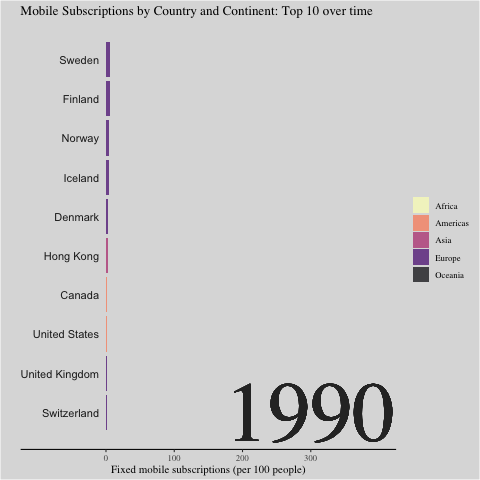
Gif No. 4
By Sascha Kuhn
tuesdata <- tidytuesdayR::tt_load('2020-11-10')
##
## Downloading file 1 of 2: `mobile.csv`
## Downloading file 2 of 2: `landline.csv`
mobile <- tuesdata$mobile
landline <- tuesdata$landline
library(tidyverse)
library(gganimate)
library(gifski)
library(magick)
#prep data
mobile_anim <- mobile %>%
mutate(entity = factor(entity),
continent = factor(continent),
gdp_per_cap = round(gdp_per_cap)) %>%
arrange(entity,year) %>%
filter(year <= 2014) %>%
# plot
ggplot(aes(gdp_per_cap,mobile_subs, size = total_pop, color = continent, frame = year)) +
labs(x="GDP per capita, PPP (constant 2011 international $)" , y = "Fixed mobile subscriptions (per 100 people)", size = "Gapminder total population", color = 'Continent', caption = "") +
geom_point() +
theme_classic() +
theme(legend.position = "none") +
scale_x_continuous(limits=c(100, 150000)) +
# gganimate code
ggtitle("Year: {round(frame_time,0)}") +
transition_time(year) +
ease_aes("cubic-in-out") +
enter_fade() +
exit_fade()
#prep data
landline_anim <- landline %>%
mutate(entity = factor(entity),
continent = factor(continent)) %>%
filter(year <= 2014) %>%
#plot
ggplot(aes(gdp_per_cap,landline_subs, size = total_pop, color = continent, frame = year)) +
labs(x="GDP per capita, PPP (constant 2011 international $)" , y = "Fixed telephone subscriptions (per 100 people)", size = "Gapminder total population", color = 'Continent', caption = "") +
geom_point() +
theme_classic() +
scale_x_continuous(limits=c(100, 150000)) +
# gganimate code
ggtitle("Year: {round(frame_time,0)}") +
transition_time(year) +
ease_aes("cubic-in-out") +
enter_fade() +
exit_fade()
# COMMENTED OUT FOR KNITTING
### render Animations
mobile_render <- animate(mobile_anim, duration = 10, fps = 20, width = 300, height = 400, renderer = gifski_renderer())
landline_render <- animate(landline_anim, duration = 10, fps = 20, width = 450, height = 400, renderer = gifski_renderer())
### Convert to mgif so both can be added into one gif
mobile_mgif <- image_read(mobile_render)
landline_mgif <- image_read(landline_render)
combined_gif <- image_append(c(mobile_mgif[1], landline_mgif[1]))
for(i in 2:200){
combined <- image_append(c(mobile_mgif[i], landline_mgif[i]))
combined_gif <- c(combined_gif, combined)
}
#### to plot in R
# combined_gif
#### to save
#anim_save("phone.gif", animation = combined_gif)

Gif No. 5
By Martin Wong
library(gganimate)
library(tidyverse)
library(tidytuesdayR)
theme_set(theme_bw())
tt <- tt_load("2020-11-10")
##
## Downloading file 1 of 2: `mobile.csv`
## Downloading file 2 of 2: `landline.csv`
mobile_data <- tt$mobile %>%
mutate(gdp_per_cap_thousands = gdp_per_cap / 1000) %>%
mutate(year = as.integer(year))
p <- mobile_gdp_animation <- ggplot(
mobile_data,
aes(x = gdp_per_cap_thousands, y=mobile_subs, size = total_pop, colour = entity)
) +
geom_point(show.legend = FALSE, alpha = 0.7) +
scale_color_viridis_d() +
scale_size(range = c(2, 12)) +
scale_x_log10() +
labs(x = "GDP per capita, PPP (constant 2011 international $, 000s)", y = "Fixed mobile subscriptions (per 100 people)") +
facet_grid(~continent)
# COMMENTED OUT FOR KNITTING
# p+
# transition_time(year) +
# labs(title = "Year: {frame_time}")
# animate(mobile_gdp_animation, duration = 2, fps = 200)
# gganimate::anim_save(here::here("2020-11-10/mobile_by_gdp_year_martin_w.gif"))
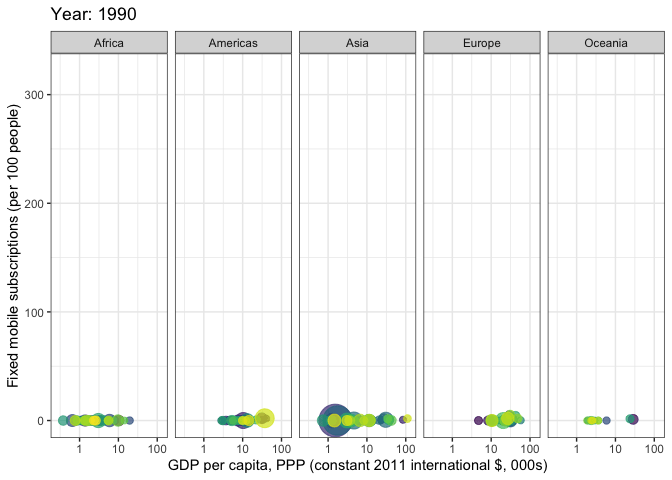
Gif No. 6
inspired by this video of Hans Rosling.
library(tidyverse)
library(gganimate)
library(scales)
library(ggthemes)
# library(prismatic) # to print color vectors to the R console
mobile <- readr::read_csv('https://raw.githubusercontent.com/rfordatascience/tidytuesday/master/data/2020/2020-11-10/mobile.csv')
landline <- readr::read_csv('https://raw.githubusercontent.com/rfordatascience/tidytuesday/master/data/2020/2020-11-10/landline.csv')
# join data
mobile_land <- left_join(mobile %>% select(code, year, mobile_subs), landline, by = c("code", "year"))
# colors
# europe: brown, asia: red, americas: yellow, africa: blue, oceania: green
pal <- c(Europe = "#B58132", Asia = "#BD2333", Africa = "#293BC6", Oceania = "#40BF58", Americas = "#B2C939")
# prismatic::color(pal) # print color vector to console!
grid_col <- "#4CA9B4"
theme_custom <- function (base_size = 12, base_family = "Poppins")
{
# code for the theme adapted from https://github.com/jrnold/ggthemes/blob/master/R/hc.R
grid_col <- "#4CA9B4"
bgcolor <- "#2a2a2b"
ret <- theme(
panel.border = element_blank(),
panel.background = element_blank())
ret <- (ret + theme(rect = element_rect(fill = bgcolor, linetype = 0,
colour = NA),
text = element_text(size = base_size, family = base_family, color = grid_col),
title = element_text(hjust = 0.5, color = grid_col),
axis.title.x = element_text(colour = grid_col, hjust = 0.5),
axis.ticks = element_line(colour = grid_col),
axis.text = element_text(color = grid_col),
panel.grid.major.y = element_line(colour = grid_col),
panel.grid.major.x = element_line(colour = grid_col),
panel.grid.minor.y = element_blank(),
panel.grid.minor.x = element_blank(),
legend.title = element_text(colour = grid_col),
legend.position = "bottom",
legend.key = element_rect(fill = "#FFFFFF00")))
ret
}
theme_set(theme_custom())
p <- ggplot(mobile_land, aes(x = mobile_subs, y = landline_subs, color = continent, size = total_pop, group = code))+
geom_text(aes(label = as.character(year)), x = max(mobile_land$mobile_subs, na.rm = TRUE) -60, y = 25, size = 22, color = grid_col, alpha = 0.01, show.legend = FALSE)+
geom_point(alpha = 0.8)+
scale_color_manual("", values = pal, na.value = "white")+
scale_size("Total population", range = c(1, 10), labels = function(x) format(x, big.mark = ",", scientific = FALSE),
guide = guide_legend(override.aes = list(color = grid_col)))+ # fill size legend "bubbles" with grid color instead of black
labs(title = "Landline and mobile subscriptions over time", subtitle = "per 100 people", x = "Mobile subscriptions", y = "Landline subscriptions")+
theme(legend.box = "vertical", legend.position = "right")
# commented out for knitting
# p+
# transition_time(year)+
# ease_aes('linear')
# gganimate::anim_save("rosling_phones.gif")
at today's @CorrelAid #tidytuesday hangout, i played around with gganimate again and took a deep dive into theme options to recreate the look of this iconic video of the great @HansRosling (RIP): https://t.co/RwoozMSlVQ #dataviz #rstats cc @jj_mllr will post code tomorrow! pic.twitter.com/4lJCoIVHYv
— Frie (@ameisen_strasse) November 10, 2020